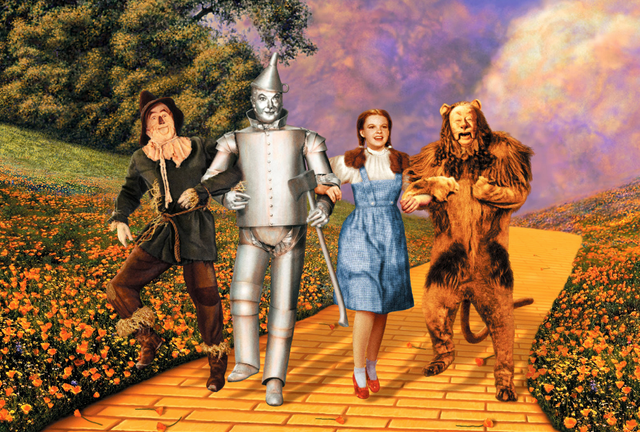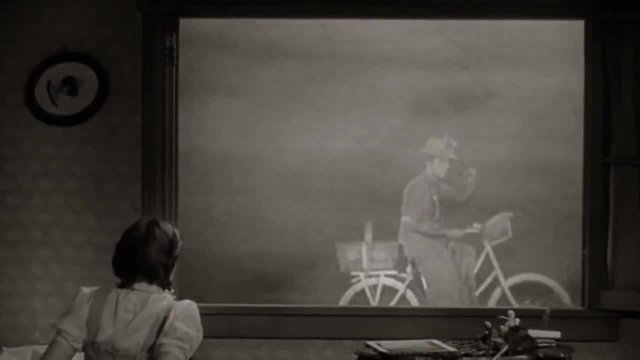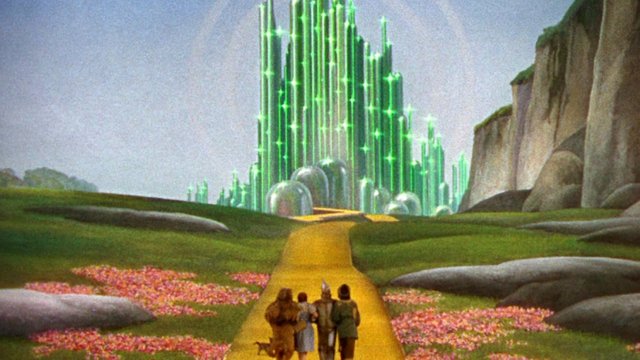Dreams, Cinema, and The Wizard of Oz

In her essay Universal Stories, Linda Seger claims, “All of us have similar experiences... Whatever the culture, there are universal stories that form the basis for our particular stories... We identify with the heroes because we were once heroic or because we wish we could do what the hero does” (Seger 192). She goes on to explain the traditional elements of a hero's journey (a mentor, a call to action, etc.), beginning by writing, “In most hero stories, the hero is introduced in ordinary surroundings, in a mundane world, doing mundane things” (Seger 192). This description can certainly be applied to Dorothy's life in Kansas in the first act of Wizard of Oz. In fact, all of the elements of Seger's interpretation of the traditional “hero's journey” can be found, in some form or another, in the film. In some cases, such as the colorless mundanity of Kansas, the elements of the hero's journey are so explicitly present, that the film seems to be inviting us to become aware of the archetypal nature of its narrative.
When we go to the movies, it would seem that our fundamental motivation is to leave the theater happier than we were when we arrived. Either that or to temporarily escape the anxieties of the world outside of the theater. Films can help us alleviate fear and stress in a number of ways, but, for the most part, they aim for escapism and catharsis. In other words, in order to make us happy, a movie will follow two main routes: It can entertain us, allowing us to leave our boring reality behind in favor of something more interesting (in the case of The Wizard of Oz, a colorful fantasy world), or it can heal us by exposing and resolving emotional conflicts that resonate with our own lives, a process defined by Aristotle as “catharsis.” In order to accomplish this therapeutic task, a movie must relate to our own life. Movies frequently use archetypal, universal characters that many, if not all of us can relate to. The characters' problems, in spite of their specificity, are often thematically similar to almost anyone's problems. If we can relate to the characters and their goals, then the movie will be far more effective. If we are emotionally engaged in the protagonist's struggle, we begin to take their side, and we become a silent companion in their journey. When we see their conflicts resolved and harmony restored to their lives, we share in that feeling of relief. In fact, the feeling of relief is ours even more than it is the characters', because the characters, of course, are not real. What we perceive to be the thoughts and actions of the characters are merely our own interpretation, a part of our own imaginary journey.
Ultimately, our satisfaction with a movie comes down to how well the film relieves the tension within us. Without tension, the story is boring, but with too much tension, you run the risk of failing to resolve the various forms of anxiety you have imparted on the audience. The plot of The Wizard of Oz adheres to Aristotle's cathartic structure perfectly, and it does so without creating excessive tension. It's successful execution of a tried and true narrative model might have had a lot to do with its popularity; however, not only does The Wizard of Oz employ a classic cinematic narrative model, it also seems to comment on the nature of that model, subtly pointing to escapism and catharsis as answers to the important question of why we, as a culture, like to watch movies in the first place.
As previously discussed, a movie is directed at an audience, and thus it must portray a struggle that the audience can relate to. The themes of The Wizard of Oz are so universal that some may argue that they reflect an opinion on the human condition more than a perspective on cinema. It is valid to suggest that The Wizard of Oz is a statement of the cathartic and escapist nature of dreams rather than of cinema; however, I believe it covers both bases by subtly equating the experience of watching a movie with having a dream.
Strangely, we watch movies as an escape from reality, but we only wish to escape our reality so that we can eventually return to it feeling spiritually uplifted and satisfied. Much like dreams, movies are a way for us to leave our mundane lives behind, but only temporarily. Our hope, aside from superficial entertainment, is that the temporary escape might help us solve our problems, as well as add some color to our lives upon our return. When looking at cinema from this perspective, the events of Wizard of Oz seem to correspond perfectly, making it hard to believe that the writers constructed the parallels coincidentally. Dorothy, overcome by anxiety caused by Mrs. Gulch's threat to take away her beloved dog Toto, falls into the dream of Oz as an escape from the overwhelming reality of her dreary, literally colorless life in Kansas. Like the protagonist in Purple Rose of Cairo, many of us go to the movies to escape dreary, colorless lives of our own. However, upon arriving in the beautiful dream-world of Oz, Dorothy immediately makes it her goal to return home to Kansas. While she craves something fantastic in her life, Dorothy ultimately values reality over the dream. The dream, however, will help her to escape, and ultimately resolve, her real-world problems, and in this way Dorothy's emotional journey closely mirrors our own journey as we watch the film.
When Dorothy dreams that she and her house are being spun up into the air by a tornado, she sits up on her bed and looks out of her window, a window that closely resembles a movie screen. Amidst the wind and debris, Dorothy sees images of the people she knows, and the audience is quickly informed that she is dreaming by the intentionally unrealistic quality of the apparitions. They do not flow naturally with the tornado winds, but are instead projected onto them, as if Dorothy is watching a little movie in her head, a movie that quickly becomes frightening as Mrs. Gulch cartoonishly transforms from a woman on a bike to a cackling witch on a broomstick. Dorothy, of course, is on an emotional rollercoaster as she watches out the window, nearly fainting with fear when the witch appears. The cinematic quality of the window is heightened by the technique used for the special effects. The activity outside of the window is from an entirely different shot that has been superimposed between the frames of Dorothy's window. The result is a moviescreen within a moviescreen. As moviegoers, we can feel ourselves being associated with Dorothy in this instance. By choosing to watch the film, we are submitting ourselves to the same emotional rollercoaster that Dorothy experiences as she dreams of looking out of her window.

Upon arriving in Oz, Dorothy steps out into a world of vibrant color and fantastic scenery. This is the world of movie-magic. Prior to this scene, the entire first act of the movie, which takes place in reality, is shot in black and white. The film was released just after the advent of color film, so the sudden shift as Dorothy steps out into Oz has a two-fold effect. Dorothy's entrance into the colorful splendor of her dream-world is at least subtly equated with our entrance into a new cinematic era. Meanwhile, particularly in this scene, there is a deliberate emphasis on the artificial, theatrical nature of this new fantasy-world. Dorothy steps out into a beautiful, albeit obvious, movie studio set, complete with plastic flowers, singing dwarves, choreographed dancing, and an extremely conspicuous, painted-on background wall. It is easy to chalk up these artificial elements to short-comings in the 1939 special effects; however, the fake flowers and the wall of the set are shown so directly and unabashedly that it seems as if we were meant to take notice. The obvious artificiality of the set takes nothing away from its beauty, however, and the color, commotion, surrealism, and Munchkin revelry all serve to anchor us in a dream space, even as the props and set seem to place us on a stage or a movie screen.
After being greeted by the Munchkins and applauded for accidentally killing an evil witch, Dorothy journeys to the Emerald City in order to find a way back home to Kansas. On her way, she encounters three companions. Each of them is lacking something that they deem critical to their happiness. Dorothy wants to return to reality and her home, the scarecrow wants a brain, the lion wants to be brave, and the tin man wants to have a heart, or, in other words, emotion. Superficially, each of these characters mirrors a person in Dorothy's own life, and each of them embodies a quality that Dorothy associates with their real life counterpart. However, looking at Dorothy's dream from a Freudian perspective, we would see these characters instead as projections of Dorothy's subconscious, and consequently, at least partially representative of Dorothy's own fears about herself. The validity of this perspective is certainly supported by Dorothy's interactions in Kansas. For example, the man who later appears as the scarecrow accuses Dorothy of being stupid before we have any chance to suspect him of being the stupid one. The man who nearly faints after rescuing Dorothy appears in Oz as the cowardly lion; however, his anxious moment arose out of his concern for Dorothy, and not out of fear for himself. Dorothy, who had been foolishly walking along the railing of the pig pen, was the one made absolutely helpless with fright. It is not a far leap, then, to suggest that Dorothy shares in the concerns of each of her imaginary companions, just as the movie-goer, the dreamer of Dorothy and her companions, can also relate to a desire to be brave, to be wise, to be empathetic, or to return home.
Dorothy and her companions continue their journey toward the Emerald City, a place that becomes increasingly associated with Hollywood as the story progresses. In real life, Hollywood embodies the American dream while simultaneously manufacturing it. We all crave freedom, justice, comfort, and fame, and what better way to achieve all four than by moving to Hollywood, becoming a celebrity, then living the rest of your life in a fantastic reality of luxury, comfort, wealth, and popularity. Hollywood repeatedly instills this desire in us. Whether we envy the characters or the actors that represent them, we can tell for sure that there's something magical about Hollywood, and for the majority of Americans, it is a place synonymous with fame, luxury, and wish fulfillment, a land of dreams that every American is forced to see as an ideal place to find an answer to their problems.
The Emerald City serves the same function. The initial fact that the city is made of emerald serves as the first association. Hollywood is known for its materialism, glitz, and glam, a veneer that hides an uglier, ego-driven underbelly. What better way to represent materialism than by having an entire city built out of a beautiful, precious mineral. The Emerald City is also regarded by the inhabitants of Oz in much the same way that Hollywood is regarded by Americans. The Munchkins all look up the Emerald City as a magical place, a place to find answers, and as the end-point in a traditional Ozian journey. There would be no need for such a stylish yellow brick road if The Emerald City was one of a plethora of equally important cities in Oz. Even though Ryan Seacrest is nowhere to be found, it is clear that in the land of Oz, going to the Emerald City is on par with being sent to Hollywood. Both cities are dream-factories, the subjects and producers of the lore pertaining to their respective nations. They are pop-culture Meccas in the most literal possible sense.

Upon arriving and gaining entry to the Emerald City, Dorothy and her companions present themselves before the Wizard of Oz in hopes of getting what they came for. Instead, the Wizard sends them a new quest: to steal the broomstick of the Wicked Witch of the West. Dorothy and her companions embark once again, ultimately defeating the Wicked Witch in the nick of time. When they return to the Emerald City, however, they make a startling discovery. The Wizard of Oz is not a wizard at all. He's just a man behind a curtain, using a bunch of bells and whistles to project a terrifying, supernatural, and larger-than-life version of himself onto what is essentially just a fancy movie-screen. The Wizard of Oz, then, becomes a stand-in for the makers of the film. He's the actor, director, and fat-cat producer of an elaborate motion picture, and he uses his illusory dramatic presentation to exert control over the entire land of Oz. Just as idolized Hollywood films are a central influence upon (and barometer of) American culture, the projection is a sort of pseudo-religious idol of Oz. And just as Hollywood is often portrayed as a place of shattered dreams and broken promises, the magic of the Emerald city is all a facade. In spite of his phoniness, however, the “wizard” is not entirely without wisdom. He tells the companions that their journey has not been in vain, that they can still find what they are looking for. The qualities they desire have been within them all along, they've all simply been lacking the self-confidence to realize their true potential.

In order to feel happy, we must have reason to believe that we deserve to feel happy. We all need the appearance of justice in our lives, so it is no surprise that poetic justice is a key element in any cathartic story. In almost any film, we are placed on the side of the good guy , and we spend an hour and a half waiting to discover whether justice will be returned to the hero's life. The good guys inevitably beat the bad guys. If not, it's probably the result of the hubris or bone-head plays of an inept, not-all-that-good good guy. Tragedy or comedy, the protagonist's final situation should be a fair and predictable outcome, made inevitable by the character's definitive personality traits. When our lives feel mundane, pointless, or unfair, we have the movies so that our minds can enter into a realm where there is justice, freedom, and purpose, before eventually returning home with the lingering effects of those invigorating ideals. Simply put, cinema is an imaginary realm full of fairy tale endings and constant poetic justice, while reality is often severely lacking in both.
This theme of achieving justice through an imaginary journey is central to my interpretation of Wizard of Oz as a metafictional take on American cinema. Dorothy's life lacks justice in several ways. Her beloved dog is being unfairly taken away by Mrs. Gulch, she gets duped by an illusionist into thinking her Aunt is going to get ill and die, and all the while she lacks the self-confidence to feel internally justified, which she evidently equates with being wise, brave, and empathetic. The subconscious goal of her journey is to acquire the justice that she seems to be lacking in her real life. In the course of her dream, Dorothy kills the Wicked Witch of the West (the dream-equivalent of Mrs. Gulch), she exposes the Wizard of Oz (the dream-equivalent of the fortune-teller) as a fraud, she affirms her bravery, wisdom, and empathy, and, most importantly, she learns to find joy in the real world (i.e. “There's no place like home!”) Meanwhile, her quest for internal and external justice is mirrored by the quest of the movie-goer. Dorothy achieves justice vicariously through a dream; meanwhile the movie-goer reaches the same end by placing themselves alongside Dorothy and sharing in her quest. Their goals and methods are essentially the same, and just as Dorothy's companions and foes exist only in her head, Dorothy and the land of Oz exist only in the head of the movie-goer.
Ultimately, our emotional state as we walk out of a theatre or turn off our TV should, in some way, parallel the emotional state of the protagonist. In most films, though, the comparison is not nearly as direct. At the end of The Wizard of Oz, we are waking up from a dream and returning to reality in much the same way as Dorothy. We return to our mundane lives, to colorless Kansas and mean old Mrs. Gulch, but we do so with a new-found invigoration, a sense of empowerment deriving from the cathartic release of mentally conquering the fantastic obstacles and foes. Dorothy achieves this catharsis through a dream, while the audience does so through a film, which begs the ultimate question: What makes watching a movie any different from a dream?
Top Image Source: Image Source